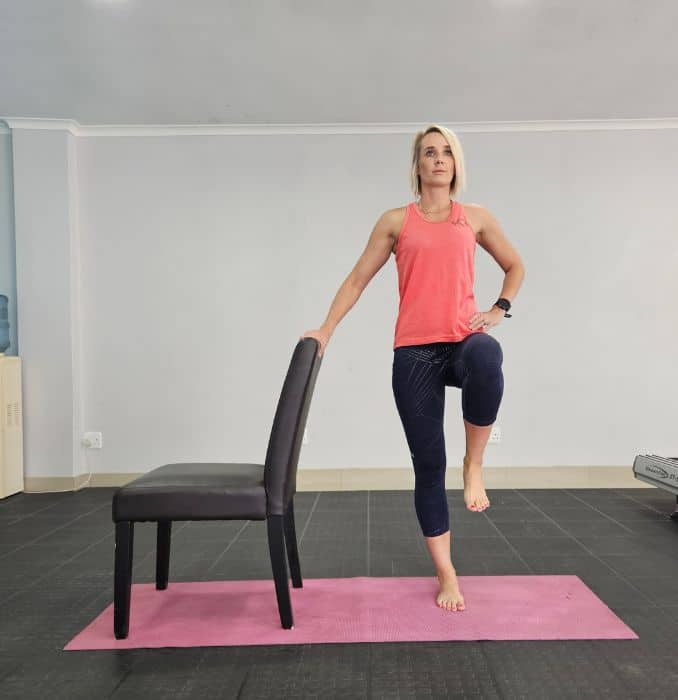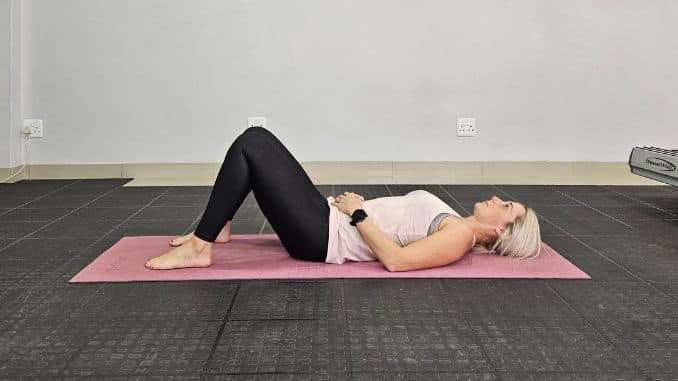Every part of our body is important, but we often don't realize how much we rely on our hips for everyday actions. Incorporating hip exercises at home can significantly improve your mobility, strength, and overall well-being, ensuring that your hips remain strong and healthy for years to come.
While we frequently focus on slimming our waist or toning our chest, we tend to forget about our hips unless they start to hurt.
Consequently limited hip range of motion has been identified as a predisposing factor for hip osteoarthritis [¹] and can significantly impact our ability to perform daily activities pain-free. Maintaining normal ranges of motion is essential for our overall function and well-being.
Hence, to help prevent injuries, improve posture, and enhance overall athletic performance, this article provides a guided exercise routine specifically tailored to target the hips, improving their mobility. By paying attention to our hip health, we can ensure better mobility and a higher quality of life.
The Crucial Roles Of The Hips
Your hips and pelvic bones are fundamental to your body's structure and function. They play a crucial role in weight-bearing and movement. Understanding the biomechanics of the hip and pelvis is essential for preventing injuries, designing effective rehabilitation programs, and promoting overall musculoskeletal health.
Therefore, let's explore the crucial role of your hips in more detail.
1. Structural Support And Weight Distribution
- Anatomical Framework: Your pelvic bones, composed of ilium, ischium, and pubis, form a ring-like structure that supports your spinal column and pelvic organs. This base is vital for the upper body's stability.
- Weight Bearing: The hips distribute the upper body's weight through the spine to the pelvis and then to the lower limbs, aiding in balance and posture. This process is supported by various muscles, including the thigh muscles and gluteal muscles, ensuring stability and distribution of weight [²].
2. Shock Absorption
- The hips and pelvis absorb and mitigate shocks during activities like walking or jumping, safeguarding the spine and upper body, with hip muscles playing a key role in this shock absorption.
3. Movement And Locomotion
- Articulation: The hip joint, supported by hip flexors, extensors, abductors, adductors, and rotators, allows extensive movement, which is crucial for walking, running, and bending.
- Muscle Attachment: Muscles and ligaments, such as the thigh muscles, hip flexors, and gluteal muscles, attach to the hips, aiding in movement and stability.
- Balance and Coordination: The hip muscles, particularly the gluteal muscles and hip flexors, are essential in maintaining balance during various activities, helping to coordinate leg movements.
4. Adaptation And Response
- Dynamic Response: The hips adjust to different physical activities, with muscles like the hip flexors and extensors responding to the demands of various movements, such as the increased load during running.
- Postural Adaptation: Activities like lifting heavy objects involve the hips, which adjust to optimize weight distribution, with involvement from the thigh and gluteal muscles.
5. Injury Prevention
- Maintaining the strength and flexibility of the hip and pelvic area through exercises recommended by a physical therapist or expert is crucial for injury prevention. Hip strengthening exercises can enhance stability, reduce the risk of hip pain, and prevent issues in other body parts.
- Weight Bearing: Your hips distribute the upper body's weight through the spine to your pelvis and lower limbs, aiding in balance and posture. Various muscles, including the thigh and gluteal muscles, support this process, ensuring stability and weight distribution.
Best Hip-Strengthening Exercises
Strengthening the hips through exercise is crucial for overall health and mobility. Have you considered how strong hip muscles can support your pelvis and improve your posture, balance, and walking efficiency?
Exercises targeting the hips enhance stability, reduce the risk of injury, and alleviate strain on other body parts, such as the knees and lower back.
Strong hips are especially vital for athletes and older adults. They help prevent falls and improve performance in various activities.
1. Standing Hip Circles
 |
 |
 |
Firstly, begin in an upright standing position with your feet shoulder-width apart. Afterward, place your hands on the hips and slowly rotate your hips, making big circles. Lastly, complete a set in one direction and then switch to the opposite direction.
2. Cross-legged Side Bend
 |
 |
Begin this Hip Exercises At Home in an upright standing position with your legs crossed. While maintaning good alignment with your head, shoulders, and hips. Raise both arms overhead and engage the core. Bend your upper body to one side. Return to the starting position, switch your feet, and repeat the movement to the other side.
3. Standing Leg Circles
 |
 |
 |
For exercise, utilize the back of the chair or wall for support if needed.
Begin in an upright standing position beside a chair with your feet hip-width apart, while maintaining good alignment with your head, shoulders, hips, and legs. Place one hand at the back of the chair for support. Engage your core. Lift your left knee at a hip level in front of you. Then, move it in a circular motion for several repetitions and switch to an opposite direction. The movement should originate from the hip joint. Lower your left foot to return to the starting position and repeat the movement on your right leg. Start with 1 set of 5 repetitions on each leg.
4. Hip Extension
 |
 |
For exercise, utilize the back of the chair or wall for support if needed.
Begin this Hip Exercises At Home in an upright standing position with your feet hip-width apart, while maintaining good alignment with your head, shoulders, hips, and legs. Place your hands on the sides. Engage your core and lift one leg straight behind. Hold the position for a couple of seconds. Then, lower your foot to return to the starting position and repeat the movement on the opposite leg. Start with 1 set of 5 repetitions on each leg.
5. Step Down
 |
 |
For exercise, you need a yoga block and utilize the back of the chair or wall for support if needed.
Begin in an upright standing position on a yoga block behind a chair, with your feet close together, while maintaining good alignment with your head, shoulders, hips, and legs. Place one hand on your hip while the other hand is at the back of the chair for support. Engage your core and gently lower one foot toward the ground while keeping the other leg straight on the yoga block. Raise your foot back to the starting position and repeat the movement. Start with one set of 10 repetitions on each leg.
6. Cross-legged Forward Fold
 |
 |
Begin this Hip Exercises At Home in an upright standing position with your legs crossed, while maintaining good alignment with your head, shoulders, hips, and legs. Place your hands on your lap. Engage your core and hinge through your hips to bend your upper body forward. Ideally, your back should be parallel to the floor. Hold this position for a couple of seconds. Raise back up to the starting position and repeat the movement. Start with 1 set of 10 repetitions.
Depending on your flexibility, you may also reach toward the ground with your hands, allowing a deeper stretch in your legs, hips, and back.
7. Happy Baby

Lie on your back on the floor with your knees bent and feet flat on the floor, relaxing your upper body. Lift your legs and hold your toes with each hand, pulling down toward the shoulders with your knees wide apart. Then, hold the position for several deep belly breaths, in through your nose and out through your mouth.
To intensify this exercise, you can gently rock your lower spine from side to side.
8. Lying Leg Lifts
 |
 |
Lie on your back on the floor with your legs extended straight. Place your hands on your belly. Contract your abdominal area then lift and straighten one leg to a 30-degree angle. Hold this position for several deep belly breaths, in through your nose and out through your mouth. Relax and return to the starting position. Repeat the movement on the opposite side.
9. Side Leg Raises
 |
 |
Lie on your side with your legs straight and your head resting on your arms. Contract your core and lift your upper leg toward the sky, keeping your toes facing forward. Lower your leg back to return to the starting position and repeat the movement on the opposite side. Start with 1 set of 5 repetitions on each side.
To make this exercise easier, you can keep your bottom knee bent for your comfort.
10. Windshield wipers
 |
 |
Lie on your back on the floor with your knees bent and your feet flat, relaxing your upper body. Place your hands on top of your belly. Engage your core and lower both knees to one side. Repeat the movement in the opposite direction. Start with 1 set of 5 repetitions on each side.
11. Figure 4

Lie on your back on the floor with your knees bent and your feet flat on the floor. Cross your left ankle over your right knee and raise both legs, holding your lower leg with both hands. Pull your knee closer to your chest to intensify the stretch. Hold this position for 10 deep belly breaths in through your nose and out through your mouth. Relax and return to the starting position. Repeat the movement on the opposite side.
12. Seated Shoulder Rolls
 |
 |
 |
Begin in an upright sitting position with your legs crossed, while maintaining a good alignment with your head, shoulders, hips, and legs. Place your hands on your knees and engage your core. Lift your shoulders, then roll them back until you feel resistance in your shoulder blades. Lower your shoulders to the starting position and repeat the movement. Relax, then repeat the movement in the opposite direction. Complete the movement for 5 repetitions in each direction.
13. Breaths

Begin in an upright sitting position on the floor with your legs crossed. Place your hands over your knees and when you’re comfortable, close your eyes. Relax your head and bring attention to your breath as you take several deep belly breaths, in through your nose and out through your mouth.
Conclusion
In conclusion, integrating hip exercises at home into your daily routine is a powerful strategy for enhancing your overall health and mobility.
Have you ever thought about how often you rely on your hips in daily activities?
Their strength and flexibility are crucial for maintaining balance, stability, and efficient movement.
By performing exercises that strengthen your hips, you can fortify these muscles, improve your posture, and reduce the risk of injuries.
These exercises, including hip exercises at home, aren't just for athletes or those who are physically active; they're essential for everyone, regardless of age or fitness level.
However, exercise alone will not guarantee flawless hips. As we age, additional risk factors emerge. Therefore, a combination of a balanced diet, a healthy lifestyle [³], and proper exercise, including hip exercises at home, remains the most effective natural remedy to combat the physical impacts of aging.
Who wouldn't want their hips to remain robust and functional?
You might be surprised at how much it can improve your quality of life, allowing you to move more freely and with greater confidence.





